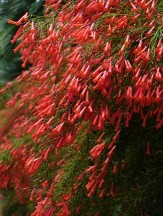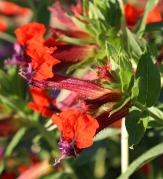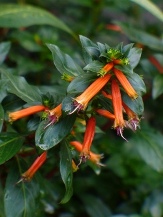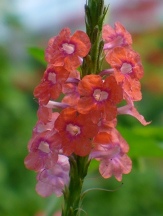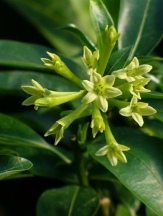4-5" wide flowers with white petals and sepals are topped by a crown of white filaments with a light purple halo surrounding the central portion of these exotic looking flowers. Bahama Blue Passion Flower is a beautiful and vigorous free flowering selection of the Blue Crown Passion Flower, Passiflora caerulea, with all its hardiness and reliability. The nectar rich flowers are adored by larger bees and the foliage is a host to a variety of butterflies. Provide a full to mostly sunny site in a moderately fertile, average moist, well-drained soil for optimum vigor and flowering. See the below information for more on growing Passionvines as perennials. Caterpillar host: Gulf Fritillary, Julia Butterfly, Variegated Fritillary, and Zebra Longwing.
Passionvines are tropical plants that we are often able to grow and enjoy as die-back perennials in areas where winter brings freezing temperatures and some can even remain evergreen in mild winters in zone 8B. *Note: To help give them the best chance of returning in the ground they should be planted as early in the growing season as possible in order for them to be able to establish a strong root system and well-established crown from which they can return the following spring. A breathable insulative protective mulch, like pine straw, will also help to improve their chances of returning. Containerized Passionvines are susceptible to the soil freezing and could be killed by it anywhere temperatures remain below 32oF for any real length of time and so may need to be brought indoors or grown in a greenhouse during cold spells. Some of the hardiest and most reliable species to look for are Blue Crown Passionvine, Passiflora caerulea, and its cultivars like Bahama Blue, Clear Sky, and Constance Elliot (these may remain evergreen even with dips into the 20oF's for short periods); Maypop Passionvine, Passiflora incarnata; and the Yellow Passionvine, Passiflora lutea. Even though these last two are considered root hardy into zones 5 and 6 they still need to be established as early in the growing season as possible. They both typically will go completely dormant in fall and winter. Other cultivars that have impressed us with their ability to return here in zone 8 are Lady Margaret (may return from the roots even in 8A ) and Aphrodite's Purple Nightie (like Blue Crown, we have seen it remain evergreen into the 20oF's for short periods).
Note: Bahama Blue Passionvine may produce fruit but it is not one that is typically grown for fruit. In order to produce their delicious tangy tropical tasting fruit Passionflowers must be cross-pollinated by another seedling, species, or cultivar. Bumblebees are perfectly designed for this as the pollen is rubbed on their back as they circle the corona drinking nectar and then carry it to the next flower. With most passionflowers the 5 stamens (pollen producing glands) arch downward once they are ready to release their pollen (and nectar) then on the next flower, hopefully, the 3 stigmas will arch downward once they are ready to receive pollen thus doing the work to produce fruit if the pollen is accepted. We generally wait until the fruits become yellow (in yellow fruited cultivars) and wrinkled and have fallen from the vine. To learn more see the
Passionfruit datasheet by Purdue Horticulture:
https://hort.purdue.edu/newcrop/morton/passionfruit.html#Varieties
Grows To: 15-20'H+
This is the average expected mature height by width in feet or inches. Feet are represented by a single quote and inches by a double quote. Parentheses are used to indicate that the plant can potentially reach that dimension, although the sizes outside of the parentheses tend to be more typical. Under poor growing conditions plants may be slightly to significantly smaller, whereas excellent growing conditions can produce larger more vigorous plants.
USDA Cold Hardiness Zones:
7*,8*,9,10,11
USDA Cold Hardiness Zones were established to give gardeners, horticulturists, farmers, nurseries, and landscape architects a universal way to describe where a plant will survive with regard to average winter lows for a region. And these are averages, here in zone 8B ('A' represents the colder half of a zone and 'B' represents the warmer half of the zone and they are separated by about 5oF) we have seen single digits but that is the exception but should be noted by the daring gardener. Each zone is separated by 10oF and the map was updated in 2012. We will continue to use the 2012 map, as the 2023 version is unrealistic. Our zones do not always agree but we try to use our own experience as to what can be depended on to return or have known reputable gardens and or horticulturists to reliably grow that plant in zones that are usually colder but sometimes warmer than what other resources have available. For more on stretching your cold hardiness zones see the ""Growing on the Edge Growing Guide". If you do not know your zone you can find it by clicking on the "USDA Cold Hardiness Zones" link here or above.
Outdoor Light: Full sun, Mostly sunny, Part shade, Part sun
- Full Sun - 8 hours or more of direct sunlight;
- Mostly Sunny - about 6 hours of direct sunlight;
- Partial Shade or Part Shade - about 4 hours of direct sunlight;
- Partial Sun - about 2-4 hours of direct sunlight;
- AM Sun or Morning Sun or Cool Sunlight - cool sunlight like early in the day, like in an eastern exposure, or very late in the day but normally in the shade during the heat of the day;
- Light Shade or Bright Shade - bright indirect sunlight for much of the day;
- Filtered Shade - may receive some amount of direct moving sunlight like through trees but usually not for any extended period especially during the heat of the day;
- Shade or Deep Shade - no or very little direct sunlight, especially not during the heat of the day.
Indoor Light: Direct sunlight to High if overwintering indoors
- Direct Sunlight - preferably 4 or more hours of direct sunlight through an unshaded south, east or west facing window;
- High Light - may tolerate no direct sunlight but will need very bright indirect light for 4 or more hours;
- High Indirect Light - bright indirect sunlight for much of the day;
- Medium Light - bright indirect light for 2-4 hours or more;
- Low Light - (few plants can do well under very low indoor light levels but some may tolerate it) no direct sunlight with little bright true sunlight filtering into the area;
- Cool Sunlight or Cool AM(morning) Sunlight - direct sunlight like in an east facing window but not during the heat of the day and will likely also tolerate cool sunlight late in the day, filtered sunlight may also be tolerated.
pH Range: Mildly Acidic, Neutral
- Acidic or Strongly Acidic - pH less than 5.5;
- Mildly Acidic - pH 5.6-6.5;
- Neutral - pH 6.6-7.3;
- Mildly Alkaline - pH 7.4-8.4;
- Alkaline or Strongly Alkaline - pH higher than 8.4;
- Note: Acid loving plants that are grown under alkaline conditions often exhibit nutrient deficiencies since the roots are not able to draw some types of minerals from the soil. Gardenias, for instance, may need to be sprayed with chelated iron. Most plants that are native to alkaline soils can be grown in neutral to mildly acidic soils successfully, although the opposite generally is not true.
Soil & Moisture: Average moist, fertile, well-drained soils.
These are the basic soil types and moisture levels where this plant will survive, not necessarily thrive. Drought resistant plants will need to be well-established, usually 2-3 years at a minimum, in the garden or landscape before they are able to withstand lengthy periods (weeks or months) without supplemental water. Most plants will grow and flower and or fruit best where they have ample moisture and nutrients available during the growing season. With that said, many plants, like prairie natives, are quite adaptable to soil types and can thrive in heavy clay as easily as a loose sandy loam.
Do you know the many benefits of a proper organic mulch? Click here to learn more.
A breathable organic mulch is not only aesthetically pleasing (looks nice) but can:
- Help to improve soil organic matter as it breaks down.
- Provide shade for the soil to help reduce moisture loss and prevent weed seed germination.
- Provide soil microbes, mycorrhizae (beneficial fungi), earthworms,and even nematode predators the necessary organic matter and ecosystem to thrive while their actions aid in improving soil tilth and or friability (think of this as the ease with which roots are able to penetrate the soil).
- Provide insulation to protect the crowns of tender perennials and die-back perennials giving gardeners up to an extra half a zone of winter warmth allowing us to grow that which we normally could not.
- Provide soil temperature moderation preventing premature soil warming in winter and providing a cooler root zone in summer.
- So which mulch is our favorite? Our preferred mulch is Longleaf Pine Straw which has: a natural weed preventative for the first year after it is applied; it is sustainably harvested; and it provides protection from soil erosion and doesn't float away, and yet is still both insulative and breathable; while Longleaf Pine Straw appears to last the longest in the garden and landscape in our opinion as compared to Loblolly.
Flowering Period: Late spring or early summer until fall.
These are the times of the year that you can expect this plant to be in flower. Most of the plants that we ship are already of flowering size and may even be in bud or flower when they are shipped but this cannot be guaranteed. The length of time a plant is able to flower is often based on its size. The more mature or better established a plant is the more resources it has to be able to expend on flowering and fruiting. Some perennials, trees, shrubs, and most vines will need about 3 years of establishment to be large enough to begin to meet their true flowering and or fruiting potential. That does not necessarily mean that they will not flower in the interim but they may not be able to flower for as long a time span. The better the growing conditions like having ample available nutrients and moisture generally equates to quicker establishment and longer flowering periods.
Fertilizing: Spring, once new growth commences, until about midsummer.
In general, plants will require the most nutrients when in active growth and less when dormant. For indoor plants and tropical plants grown in a warm greenhouse or atrium this may be year round. For winter growing perennials, like Louisiana Iris that go dormant in late summer, this may mean fertilizing in fall and winter. For spring and summer growing perennials, and practically all trees, shrubs, and perennial and woody vines in the garden we generally start fertilizing as early as 6 weeks prior to bud break (about Valentine's Day here in zone 8B in Louisiana) and they can be fertilized up to about 6 weeks prior to the earliest expected hard frost or freeze (about mid-August here in our gardens). This allows for tender new growth, and the entire plant really, to "harden off" prior to what could be potentially damaging temperatures and ultimately causing more harm than good.
One of the most common questions that we get is what fertilizer do you recommend? Obviously it will depend on the particular plant but a good quality, slow-release, non-burning fertilizer is what we prefer. Each time it rains or each time you water your plants are getting fed. Most of these fertilizers are either slowly dissolved or osmotically passed through the outer layer of a pellet. We use Scott's Osmocote© 14-14-14 and 18-6-12 on 99% of the plants that we grow, it is more expensive than some fertilizers but we can depend on the results. DO NOT use common garden fertilizers (like 8-8-8,12-12-12) on acid loving plants as it may contain lime as a filler and so can be deadly to plants like Blueberries, Azaleas, and Camellias.
When to Plant: In spring once all danger of freeze and frost have passed and soil temperatures have warmed significantly until about midsummer.
Preferred planting seasons ranging in order of the most optimum to least optimum times for ease of establishment. Container grown plants, like what we ship, can be successfully transplanted anytime of year as long as proper care is provided. This gives container grown plants an edge on bareroot plants. With that said, there are easier and harder times to establish some plants mainly due to the additional moisture required by the plant during the main growing seasons like spring and summer. If you keep that in mind there is no reason that the great majority of plants can't be added to the garden anytime of year.
This plant may be toxic to humans and/or animals, click here for details
Please be advised that humans and/or animals may have allergic reactions if part(s) of this plant are consumed or by coming into contact with sap from bruised or broken plant parts: With the exception of the sweet and tangy tropical flavored ripe pulp surrounding the dark colored seeds, other plant parts may be toxic if ingested.
Container Plant Growing Guide - includes uppotting, repotting, potting soil selection, proper watering techniques for containers, what does brown or yellow foliage and green soil indicate, and more
See our Planting A New Plant In the Garden or Landscape, How To, and General Growing Guide for basic planting, initial watering and estabishment watering in instructions
The information listed above that has a black arrow symbol, ‣, before the property name is expandable (just click on it anywhere) and it will contain additional details and a more in-depth description of the terms that we use in this plant's description. This information is based on our years of experience both gardening and growing plants, input from other horticulturists, nursery people, gardeners, and research. If you feel we are missing important information about a plant please feel free to share it with us so that we can pass it on.
![]()

